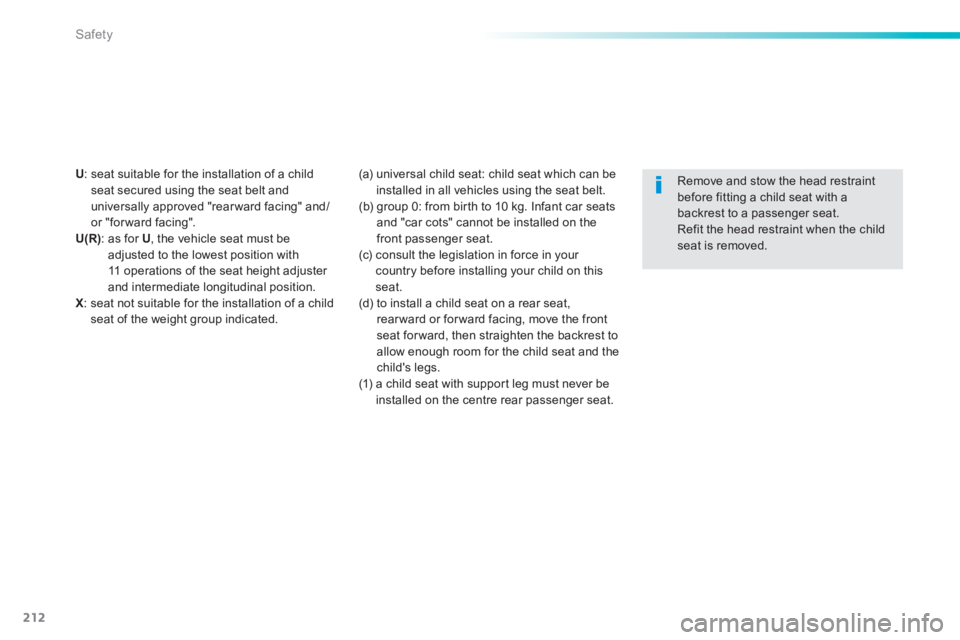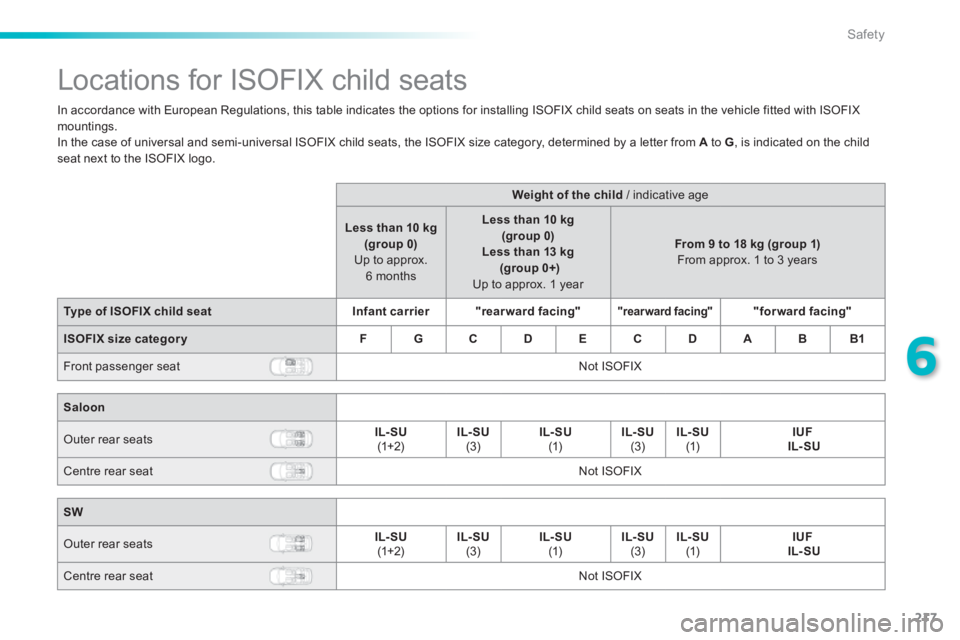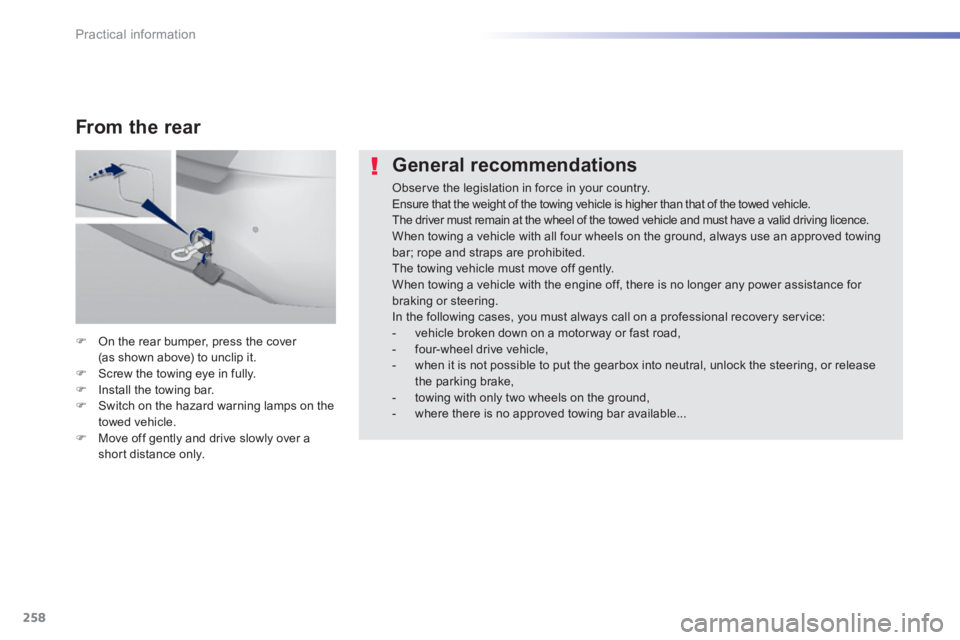Page 5 of 400

Contents
308_EN_CHAP00A _SOMMAIRE_ED02-2013
M i r r o r s 170
Lighting 173
Daytime running lamps 177
Automatic illumination of headlamps 178
Headlamp adjustment 180
Wipers 181
Automatic rain sensitive wipers 183
Courtesy lamps 185
Interior mood lighting 186
Temporary puncture repair kit 221
Changing a wheel 227
Snow chains 234
Changing a bulb 235
Changing a fuse 245
12 V battery 251
Energy economy mode 255
Changing a wiper blade 256
Towing the vehicle 257
Very cold climate screen 259
Towing a trailer 260
Fitting roof bars 262
Accessories 264
Bonnet 267
Petrol engine 268
Diesel engine 269
Running out of fuel (Diesel) 270
Additif AdBlue® additive and SCR system ® additive and SCR system ®
(Blue HDi Diesel) 271
Checking levels 280
Checks 283
Engines 285
Weights 285
Dimensions 286
Identifi cation markings 287
Direction indicators 187
Hazard warning lamps 187
Emergency or assistance call 188
Horn 188
Tyre under-infl ation detection 189
ESC system 193
Seat belts 196
Airbags 199
Child seats 204
Deactivating the passenger's front airbag 207
ISOFIX child seats 213
Child lock 220
Visibility
Safety Practical information
Checks Technical data
.
Emergency or assistance
289
DENON equipment 291
Touch screen 293
PEUGEOT Connect Sound (RD5) 365
Audio equipment and telematics
Alphabetical index
Page 11 of 400
9
.Visual search
308_EN_CHAP00B_ AIDE VISUELLE_ED02-2013
Maintenance - Technical data
Dimensions 286 Identification markings 287
Running out of fuel, Diesel 270
Checking levels 280 -282 - oil - brake fluid - coolant - screenwash, headlamp wash fluid - additive (Diesel with particle emissions filter) Checking components 283 -284 - battery - air / passenger compartment filter - oil filter - particle emissions filter (Diesel) - brake pads / discs
Changing bulbs 235-244 - front - rear
12V battery 251-254 Load reduction, economy mode 255 Engine compartment fuses 245, 249 -250
Opening the bonnet 267 Under the bonnet, petrol 268 Under the bonnet, Diesel 269 Petrol engines 285 AdBlue 271-279
Weights 285
Page 206 of 400
204
Safety
308_EN_CHAP06_SECURITE_ED02-2013
General points relating to child seats
For maximum safety, please observe the following recommendations: - in accordance with European regulations, all children under the age of 12 or less than one and a half metres tall must travel in approved child seats suited to their weight , on seats fitted with a seat belt or ISOFIX mountings * , - statistically, the safest seats in your vehicle for carr ying children are the rear seats, - a child weighing less than 9 kg must travel in the "rearward facing" position both in the front and in the rear.
PEUGEOT recommends that children should travel on the rear seats of your vehicle: - "rearward-facing" up to the age of 3,
- "forward-facing" over the age of 3.
Although one of PEUGEOT main criteria when designing your vehicle, the safety of your children also depends on you.
* The rules for carrying children are specific to each country. Refer to the legislation in force in your country.
Page 213 of 400
211
6
Safety
308_EN_CHAP06_SECURITE_ED02-2013
Locations for child seats secured with the seat belt
Weight of the child / indicative age Weight of the child / indicative age Weight of the child /
SeatLess than 13 kg (groups 0 (b) and 0+) Up to 1 year approx
From 9 to 18 kg (group 1) From 1 to 3 years approx
From 15 to 25 kg (group 2) From 3 to 6 years approx
From 22 to 36 kg (group 3) From 6 to 10 years approx
Front passenger seat (c)
- with height adjustment U (R)U (R)U (R)U (R)
- without height adjustment (straightening the backrest) U (R)U (R)U (R)U (R)
In accordance with the European regulation, this table indicates the options for the installation of child seats secured using the seat belt and universally approved (a) in relation to the weight of the child and the seat in the vehicle.
Saloon
Outer rear seats (d) UUUU
Centre rear seat (d) U (1) U (1) UU
SW
Outer rear seats (d) UUUU
Centre rear seat (d) XXXX
Page 214 of 400

212
Safety
308_EN_CHAP06_SECURITE_ED02-2013
U : seat suitable for the installation of a child seat secured using the seat belt and universally approved "rearward facing" and/or "for ward facing". U(R) : as for U , the vehicle seat must be adjusted to the lowest position with 11 operations of the seat height adjuster and intermediate longitudinal position. X : seat not suitable for the installation of a child seat of the weight group indicated.
Remove and stow the head restraint before fitting a child seat with a backrest to a passenger seat. Refit the head restraint when the child seat is removed.
(a) universal child seat: child seat which can be installed in all vehicles using the seat belt. (b) group 0: from birth to 10 kg. Infant car seats and "car cots" cannot be installed on the
front passenger seat. (c) consult the legislation in force in your country before installing your child on this seat. (d) to install a child seat on a rear seat, rear ward or for ward facing, move the front seat for ward, then straighten the backrest to allow enough room for the child seat and the child's legs. (1) a child seat with support leg must never be installed on the centre rear passenger seat.
Page 219 of 400

217
6
Safety
308_EN_CHAP06_SECURITE_ED02-2013
Locations for ISOFIX child seats
In accordance with European Regulations, this table indicates the options for installing ISOFIX child seats on seats in the vehicle fitted with ISOFIX mountings. In the case of universal and semi-universal ISOFIX child seats, the ISOFIX size category, determined by a letter from A to G , is indicated on the child seat next to the ISOFIX logo.
Weight of the child / indicative age
Less than 10 kg (group 0) Up to approx. 6 months
Less than 10 kg
(group 0) Less than 13 kg (group 0+) Up to approx. 1 year
From 9 to 18 kg (group 1) From approx. 1 to 3 years
Type of ISOFIX child seatInfant carrier"rearward facing""rearward facing""forward facing"
ISOFIX size categor yFGCDECDABB1
Front passenger seat Not ISOFIX
Saloon
Outer rear seats IL- SU (1+2) IL- SU (3) IL- SU (1) IL- SU (3) IL- SU (1) IUF IL- SU
Centre rear seat Not ISOFIX
SW
Outer rear seats IL- SU (1+2) IL- SU (3) IL- SU (1) IL- SU (3) IL- SU (1) IUF IL- SU
Centre rear seat Not ISOFIX
Page 220 of 400

218
Safety
308_EN_CHAP06_SECURITE_ED02-2013
I UF: seat suitable for the installation of an I sofix U niversal seat, " F or ward facing" secured using the upper strap. IL- SU: seat suitable for the installation of an I sofix S emi- U niversal seat either: - "rear facing" fitted with an upper strap or a support leg, - "for ward facing" fitted with a support leg, - an infant car seat fitted with an upper strap or a support leg.
For advice on securing of the upper strap, refer to the "ISOFIX mountings" section.
X: seat not suitable for the installation of a child seat for the weight group indicated. (1) move a seat without height adjustment for wards by 1 notch from the mid position for wards and backwards A seat with height adjustment must be in the highest position. (2) the installation of an infant carrier on one of the outer seats makes use of the other two seats impossible. (3) a seat with height adjustment must be placed in the highest position. Move the seat without height adjustment for ward by 5 notches from the mid-position for wards and backwards.
Remove and stow the head restraint before fitting a child seat with a backrest to a passenger seat. Refit the head restraint when the child seat is removed.
Page 260 of 400

258
Practical information
308_EN_CHAP07_INFO PR ATIQUES_ED02-2013
General recommendations
Observe the legislation in force in your country. Ensure that the weight of the towing vehicle is higher than that of the towed vehicle. The driver must remain at the wheel of the towed vehicle and must have a valid driving licence. When towing a vehicle with all four wheels on the ground, always use an approved towing bar; rope and straps are prohibited. The towing vehicle must move off gently. When towing a vehicle with the engine off, there is no longer any power assistance for braking or steering. In the following cases, you must always call on a professional recovery service: - vehicle broken down on a motor way or fast road, - four-wheel drive vehicle, - when it is not possible to put the gearbox into neutral, unlock the steering, or release the parking brake, - towing with only two wheels on the ground, - where there is no approved towing bar available...
On the rear bumper, press the cover (as shown above) to unclip it. Screw the towing eye in fully. Install the towing bar. Switch on the hazard warning lamps on the towed vehicle. Move off gently and drive slowly over a short distance only.
From the rear